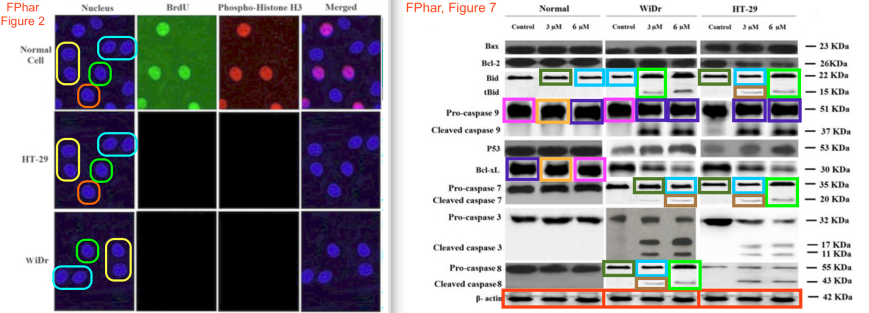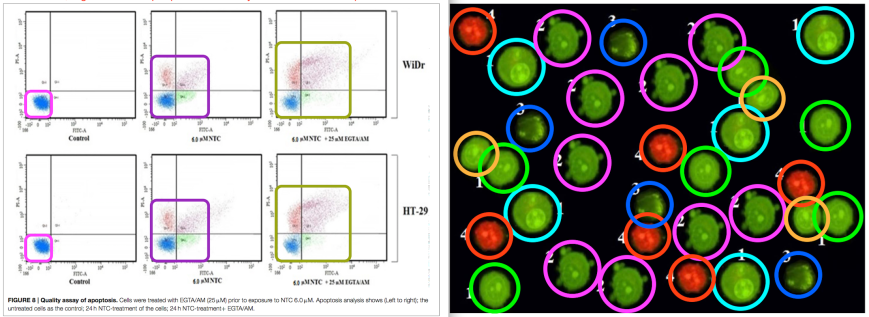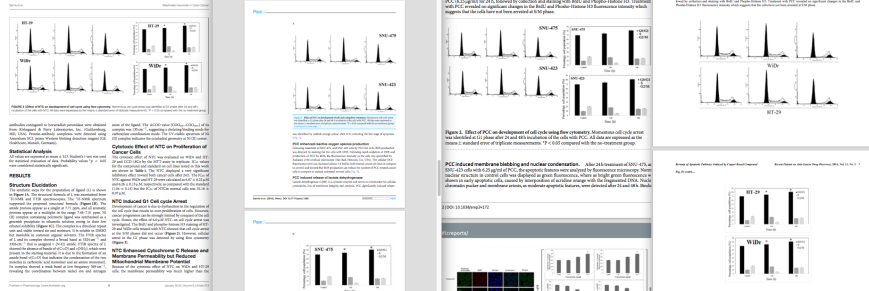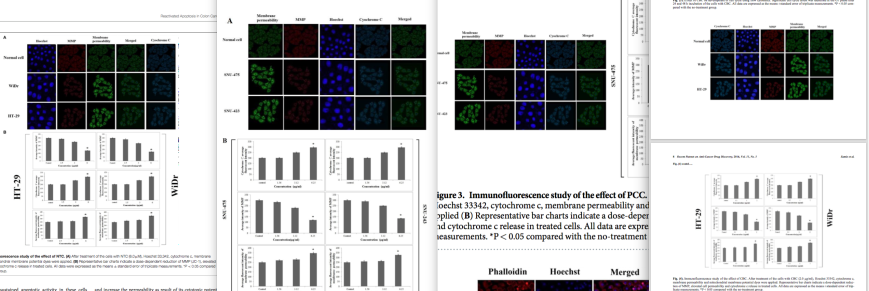One of the topics discussed today on Twitter was a set of four very similar papers by the same group from Malaysia, all published around the same time, but with different titles and in different journals. The problems were first spotted by Dave Williamson on Twitter:

Soon followed other tweets by Stuart Cantrill, Christophe Leterrier, Alexis Verger, and many others, who found more and more problems with papers by this group.
As already pointed out in posts in Retraction Watch, For Better Science by Leonid Schneider, and other blog posts, there are a lot of apparent problems with these studies. Not only do these papers contain a lot of very similar looking figures, most of the figures themselves appear to contain duplicated panels or parts of panels.
These 4 papers contain very similar examples of inappropriate image duplication as Arturo Casadevall, Ferric Fang and I wrote about in our paper that was published earlier this week in mBio:
The Prevalence of Inappropriate Image Duplication in Biomedical Research Publications – Elisabeth M. Bik, Arturo Casadevall, Ferric C. Fang – mBio
In our paper, we scanned over 20,000 published papers that contained the term “Western Blot” and screened all photographic images for duplicated panels, or lanes within panels. About 1:25 of the papers contained inappropriately duplicated images. That suggests that peer review and journal editors need to do a better job in catching these problems before publication.
The 4 papers that attracted attention today had very similar problems as the ones we encountered in our paper, but they also looked very similar to each other. The four-some were published respectively in Frontiers in Pharmacology, PeerJ, Scientific Reports, and Recent Patents on Anti-Cancer Drug Discovery. At the bottom of this post I will show the side-by-side screenshots of the 4 paper, showing how similar their figures are. But there are also a lot of potential problems with the figures, such as photos representing different cell lines that share similar features, or bands within the same Western Blot panel that look very similar to each other. What makes these papers unique is that they have so many apparent problems within one paper. Here are some examples (colored boxes are mine to point out similar looking features such as cells or bands):


You can see more examples of what-seem-to-be inappropriate duplications on the PubPeer website, for the Frontiers in Pharmacology paper, and the Scientific Reports paper. Several people, including I, have left comments and concerns about the figures. I hope that by showing these examples, peer reviewers and editors will better recognize potential figure problems, and pay more attention in capturing these mistakes before they are published. I also hope that the authors will respond to our concerns.
To show how similar the papers are to each other, I have made screenshots of a side-by-side comparison of the 4 papers. In all screenshots below, you will see from left-t0-right: Frontiers in Pharmacology, PeerJ, Scientific Reports, and the Patents paper. Note that although the papers represent studies on different cell lines or chemicals, their figures look unexpectedly similar to each other.

FPh Fig 2 – PeerJ Fig 2 – SciRep Fig 1 – Patent Fig 2

FPh Fig 3 – PeerJ Fig 3 – SciRep Fig 2 – Patent Fig 3

FPh, Fig 4 – PeerJ Fig 4 – SciRep Fig 3 – Patent Fig 4
NA -PeerJ Fig 5 – SciRep Fig 4 – Patent Fig 5

NA -PeerJ Fig 6 – SciRep Fig 5 – Patent Fig 6

NA – PeerJ Fig 7 – SciRep Fig 6 – Patent Fig 7

NA – PeerJ Fig 8 – SciRep Fig 8 – Patent Fig 8

FPh, Fig 5 – PeerJ Fig 10 – SciRep Fig 10 – Patent Fig 10

FPh, Fig 6 – PeerJ Fig 11 – SciRep Fig 11 – Patent Fig 11

FPh, Fig 7 – PeerJ Fig 12 – SciRep Fig 12 – Patent Fig 12

FPh, Fig 8 – PeerJ Fig 13 – SciRep Fig 7 – Patent Fig 13


Fantastic work. Terrible paper(s).
LikeLiked by 1 person
There appears to be quite a bit of textual overlap as well. Take two of the papers, copy the texts, and throw one on each side of this text comparator http://people.f4.htw-berlin.de/~weberwu/simtexter/app.html and click on “compare”. Text that is identical in each column is colored in the same color in the other column. If you click on a piece of colored text in one column, the other column aligns itself so that one can clearly see that there is a lot of template text: NTC becomes PCC, colon cancer becomes liver cancer, etc.
LikeLiked by 1 person
Terrible author how many paper he want on the basis on few image ?? Enough. The authors should be ashamed. The reviewers, journal office all should also be ashamed for letting something like this pass. Who looked at this stuff?
LikeLike
Thanks for spending so much efforts on studying and – even more important – reporting these inappropriate figures. I am wondering what the reviewers did since even though they might not have had the overview of all four publications they should have noticed the suspected manipulations.
LikeLike
Great work Elisabeth!
Clearly a review of QC processes at all these journals is necessary.
LikeLike
the cells in fig6 and the histology panels in fig14 of the Sci Reps paper were taken from Zahedifard etal Sci Reps 2015 fig6 and fig11, just sayin….
LikeLike
yes you are right
LikeLike
Comment including my one is deleted from above sci. report paper. I don’t know what is the wrong with nature. If some one want i can share the proof that my comment has been disappeared.
LikeLike
The Scientific Reports website was done for a bit, but came back to life today. The comments are back as well.
LikeLike
Pingback: Triplicated paper with multiplicated cells and images – For Better Science
Update: The University of Malaya published a statement today:
“As the University of Malaya adheres to a strict policy of research integrity and ethical practices, the authors have been asked to retract all the four published articles immediately.”
https://www.um.edu.my/about-um/media-centre/news/2016/06/16/allegations-of-scientific-misconduct-at-university-of-malaya
LikeLike
Pingback: Dr. Ong Kian Ming (王建民) | How serious is academic fraud in our universities?
Pingback: Dr. Ong Kian Ming (王建民) | 我国大学的学术造假现象到底有多严重?
Pingback: Betapa seriuskah penipuan akademik di universiti kita? – Dr. Ong Kian Ming (王建民)
Pingback: Has peer review hit rock bottom? - Principia Scientific International